A two-day trip to a mega city, with a preponderance of excellent attractions, can be overwhelming. With jet lag slowing my pace, coupled with intermittent rain dissuading outdoor activities, I set aside one day to learn about Hong Kong’s history. The best place to begin my adventure was at the Hong Kong Museum of History. This museum was established in 1975 “to preserve and promote the historical and cultural heritage of Hong Kong.”
HONG KONG MUSEUM OF HISTORY
The focal point of this institution is the permanent exhibit—The Hong Kong Story. It includes eight galleries and over 4,000 exhibits incorporating 50 multimedia programs. Each gallery explores the historical period using authentic materials as well as video presentations that provide a narrative of key points. The ten videos range from four to eleven minutes in duration
This historical journey begins with the Devonian Period, 400 million years ago, and ends in 1997 with the return of Hong Kong’s sovereignty to China. By using just a little bit of one’s imagination, visitors can easily go back in time as they visit each gallery. The signs have English translations and the videos can be watched in Cantonese, Putonghua, or English. When I visited, the permanent exhibit was free.
The Natural Environment
This first gallery showcases landforms, climate, flora, and fauna. Rocks and fossils are used to introduce visitors to a range of geological periods. In a theater, I witnessed millions of years of changes that transformed Hong Kong’s landscape. Another area replicates four major ecosystems— a climax forest, a stream flowing through a forested area, a wetland with mangroves, and a bamboo forest. Each section is filled with models of indigenous birds, reptiles, and mammals.
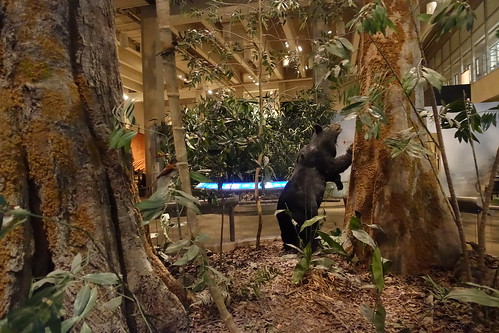
Prehistoric Hong Kong
Six thousand years ago, the people congregated on the sand dunes by the sea. To bring this time period to life, the curators made a replica of one of the eight known rock carvings discovered in the city and incorporated artifacts from the time period into a beach scene that illustrates daily life. Like other museum exhibits from this era, the displays concentrate on the simple tools used by the inhabitants— pottery, stone, and bronze objects.
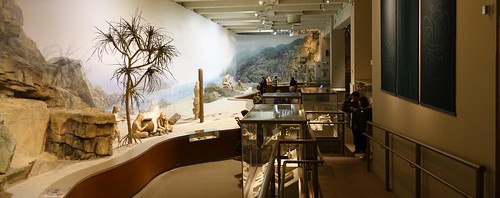
The Dynasties: From the Han to the Qing
The dynasties are a fascinating part of Chinese history. The charts and displays help foreign visitors sort out the different eras and also illustrate how the migration of people from various regions affected Hong Kong’s growth and economy.
Folk Culture in Hong Kong
Four Chinese ethnic groups, the Punti, the Hakka, the Boat Dwellers, and the Hoklo are introduced in this part of the exhibit. The emphasis is on their diverse lifestyles from farming on the plains to being coastal fishermen. Interestingly, the Boat Dwellers had minimal interaction with the people who lived on the land. They spent almost all of their lives in their boats.
This section of the museum includes a cross section of cultural and religious practices. The Lighting Lantern Ceremony display describes Hong Kong’s clan based tradition initiating male infants into the community. Other areas provide examples of rituals associated with honoring ancestors, marriage ceremony traditions, and the celebration of festivals.
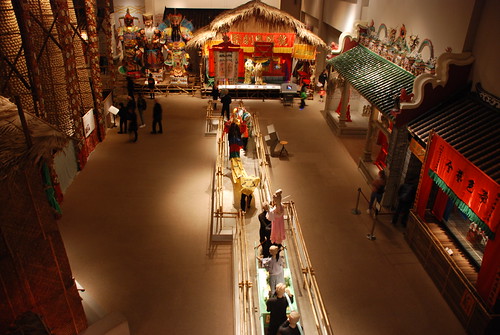
The Opium Wars and the Cession of Hong Kong
The Age of Discovery led to an era when China could be reached by sea rather than the land routes that crossed the Middle East. The Portuguese, Dutch, British, and other European merchants used the sea route to enhance their business opportunities.
By the mid 19th century, Hong Kong had become a major port filled with large cargo ships. With the influx of trade came the opium wars and the surrender of Hong Kong to the British in 1841.

Birth and Early Growth of the City
This part of the exhibit highlights port life in the early part of the twentieth century. An emphasis is placed on how Hong Kong became a place where the East meets the West. The daily lifestyles of the city’s inhabitants are captured in the exhibits.
Japanese Occupation
After an 18-day battle, the Japanese occupied Hong Kong for three years and eight months. An air-raid shelter setting provides the backdrop for the historical displays depicting the horrific conditions imposed on Hong Kong’s civilians.
Modern Metropolis and the Return to China
The final stop focuses on the post war development of Hong Kong and the process that led to the Handover Ceremony that returned the sovereignty of Hong Kong to China.
I entered the museum with a tiny bit of information about Hong Kong. A few hours later, Hong Kong’s history had come alive. For my remaining time in the city, I could connect bits and pieces of what I learned at the museum with what I was experiencing. If time were not a factor, I would have considered visiting other parts of the museum. Despite the inclement conditions, I didn’t want to leave Hong Kong without visiting a couple of Chinese temples.
CHINESE TEMPLES
Many reliable sources claim that Hong Kong has more than 600 temples. With so many options, I searched the Discover Hong Kong website for additional information. The Hong Kong temples were built during a variety of time periods and represent several religions with an abundance of deities. With a lack of time and less than favorable weather conditions, I selected a temple in Kowloon that was in the vicinity of the museum and another temple located in a popular area of Hong Kong Island.
Sik Sik Yuen Wong Tai Sin Temple, Kowloon
While convenience was the main criteria for visiting this complex, I was intrigued by this temple’s assertion that they could “make every wish come true upon request.” Even though I do not practice Taoism, Buddhism, or Confucianism, I wanted to know more.
My Uber driver dropped me off in front of the main entrance to a large complex with numerous buildings. The first structure was established in 1921 as a private shrine for Pu Yi Tan Taoists and their family members. A few decades later, the temple was opened to the public and over time the benevolent Sik Sik Yuen organization constructed additional buildings. Some were designated for worshipping while others provide medical, educational, and social services.
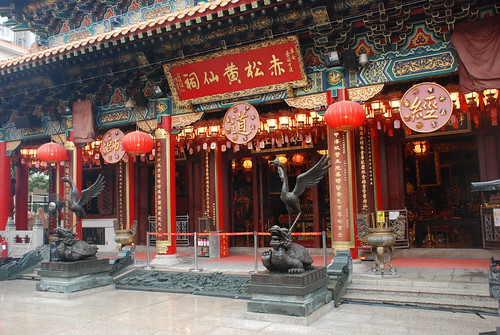
As I weaved my way in and out of the congested areas where many Asians were lighting incense and making offerings near shrines, I read the signage, admired the Asian architecture, and looked for the five-geomantic elements of feng shui—metal, wood, water, fire, earth. To get away from the crowds, I strolled through the interior garden and admired the blossoming flowers as the rain pelted the pavement. This setting provided a tranquil and peaceful environment as I read through the pamphlet that described the purpose of each building.
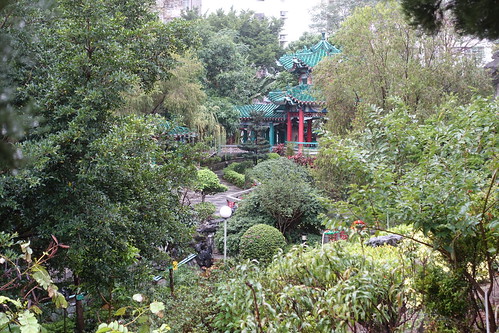
Man Mo Temple, on Hollywood Road in Sheung Wan
Hollywood Road has been one of Hong Kong’s main thoroughfares for more than a century. Tourists come here to shop at antique stores, art galleries, fashion boutiques, and to try local cuisine.
Along this route, I visited Man Mo Temple. Visitors who can read Chinese characters will appreciate the gold plaque that hangs on the doorway. The message translates to “Protection for all by the power of God.”
Once inside, I observed a handful of people standing in the central area burning incense. The smoke coming from the lit incense carries the faithful’s wishes to the gods. A few others were devotedly worshipping individually near an assortment of statues. Near the altar a few middle-aged worshippers were kneeling before the altar shaking a container with dozens of sticks. None of the worshippers were distracted by the influx of visitors snapping photos.
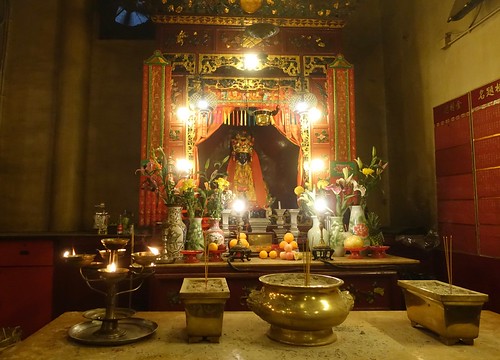
This popular 19th century structure incorporates three separate buildings. The main building (on the far left) was built to worship Man Cheong (God of Civil or Literature) and Mo Ti (God of martial arts). Followers believe that these gods were once people who lived centuries ago and were deified for their actions.
In the middle building, the deity of Kwun Yum, the Goddess of Mercy, is worshipped. Perhaps, I never paid much attention to the gender of the statues. I found this goddess’ presence intriguing and worthy of further exploration.
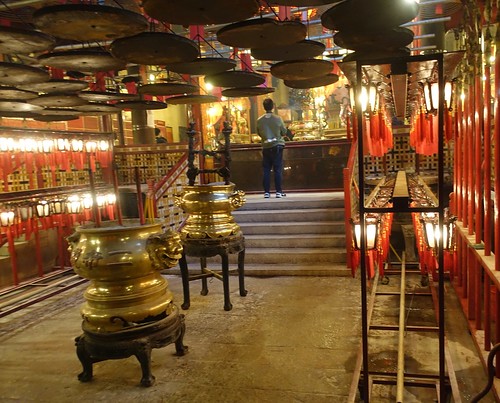
I learned decades ago that it’s always wise to have contingency plans when you’re traveling. Indoor venues, such as museums, are welcomed places when the weather isn’t cooperating with your plans. In this case, the persistent rain opened up the opportunity to visit the Hong Kong Museum of History and gain a wider appreciation of the city’s past. Had I not taken a few hours to visit The Hong Kong Story, I would have departed Hong Kong with a hodgepodge of ideas about the city.
By including a couple of temples, I was able to observe how Chinese traditions connect with people today. My ignorance of some of these customs ignited my curiosity and caused subsequent internet searches. Yes, history did come alive in Hong Kong when I stood in these temples trying to grasp Hong Kong’s culture.
Sandy, our History Comes Alive Through Travel Editor, has visited more than 40 countries and lived as an international teacher in Bangalore, India. Sandy’s award-winning book, May This Be the Best Year of Your Life, is a resource for people contemplating an expat lifestyle and living outside their comfort zone. Sandy writes about Jewish culture and history, historical sites, family, intergenerational, and active midlife adventures highlighting land and water experiences.
All photos were contributed and copyrighted by TheTravelingBornsteins.com.
